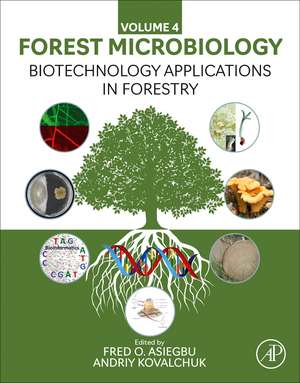Biotechnology Applications in Forestry: Forest Microbiology Volume 4: Forest Microbiology
Editat de Fred O Asiegbu, Andriy Kovalchuken Limba Engleză Paperback – 22 ian 2025
Novel techniques and current advances in the application of modern biotechniques in tree health protection, mushroom technology, biological control, biochar, bioenergy, Isolate & strain selection, metabolic engineering and commercial application relevant for forest ecosystem are also addressed.
- Outlines novel approaches in the use of fungi or bacteria for biocontrol of insect pests and invasive plant species
- Highlights the many functions and uses of forest microbes as biofertilizers, in soil fertility, and in bioremediation, including phytoremediation
- Addresses major industrial and biotechnological applications of forest microbes
Preț: 955.40 lei
Preț vechi: 1254.14 lei
-24% Nou
Puncte Express: 1433
Preț estimativ în valută:
182.82€ • 191.26$ • 151.87£
182.82€ • 191.26$ • 151.87£
Carte tipărită la comandă
Livrare economică 26 martie-09 aprilie
Preluare comenzi: 021 569.72.76
Specificații
ISBN-13: 9780443219030
ISBN-10: 0443219036
Pagini: 482
Dimensiuni: 216 x 276 mm
Greutate: 1.26 kg
Editura: ELSEVIER SCIENCE
Seria Forest Microbiology
ISBN-10: 0443219036
Pagini: 482
Dimensiuni: 216 x 276 mm
Greutate: 1.26 kg
Editura: ELSEVIER SCIENCE
Seria Forest Microbiology
Cuprins
- Biotechnology: history, processes, and prospects in forestry
- Introduction to genomics
- Next-generation sequencing: principles and technical considerations
- Introductory applied bioinformatics
- How to conduct phylogenetic analysis with molecular data
- Entomopathogenic fungi: harnessing nature’s biocontrol agents for sustainable forest pest management
- Microbial control in forestry
- Use of interfering RNA strategies and phages for the control of forest pathogens, pests and diseases
- Low-risk pesticides in the EU: economic and regulatory considerations for agriculture and forestry
- Nitrogen-fixing organisms
- Arbuscular mycorrhizal fungi
- Biochar in forestry
- Innovative approaches in phytoremediation research
- Filamentous fungi in biotechnology
- Medicinal plants and trees: methods of extraction and isolation of bioactive compounds with emphasis on some selected African medicinal plants
- Medicinal properties of wild and cultivated mushrooms from the tropics: Malaysia as a case study
- Novel wood-based biomaterials
- Biopulping, biobleaching, and deinking
- Tree population genomics
- Genetically modified trees (concept, principles, and applications)
- Somatic embryogenesis: concept, principles, and applications
- Regulatory considerations for the release of genetically modified trees
- Climatic and stress memory in trees - and how to study it
- Remote sensing approaches for assessing and monitoring forest health
- Artificial intelligence in forest management and tree health protection

